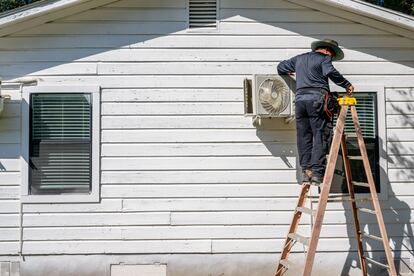Heat wave scorches the United States: More than 77 million people on alert for extreme temperatures
The atmospheric phenomenon crosses the northwestern part of the country, where temperatures are expected to peak between Wednesday and Friday, with heat index values that will exceed 100°F (37.7°C)


In New York, an event signals the arrival of summer and with it, the suffocating heat that becomes more extreme every year: fire hydrants open and the streets are transformed into small water parks. This is what happened on Tuesday with the arrival of the first heat wave of the season, which will affect most of the United States until the weekend. The heat wave has been hitting the Midwest since last Monday, and has moved rapidly toward the northwest, where temperatures are expected to peak between Wednesday and Friday, with heat index values (which measures what a temperature feels like by taking into account humidity) exceeding 100°F (37.7°C) in several locations.
On Tuesday, more than 77 million people, from Iowa to Maine, were under some level of alert due to what the National Weather Service has called a “dangerous and long duration” heat wave. Not only will the atmospheric phenomenon lead to the warmest temperatures so far this year, the federal agency warned that the heat will be also be more dangerous due to its “persistence,” as well as the light winds and high levels of humidity. Hundreds of records for high temperature are likely to be reached or broken throughout the week, with temperatures soaring as much as 25°F above average. At night, there will be no relief either: temperatures will remain above 70°F (21°C).

The heat wave, which will move southeast late this week and early next week, is fueled by an intense heat dome that has settled over the eastern half of the country. A heat dome occurs when a layer of warm air builds up near the Earth’s surface and becomes trapped by a layer of cooler air above it. The trapped air becomes increasingly hotter, creating a kind of oven effect. The high temperatures generated by this hot air mass can last for several days or weeks, causing dangerous heat waves like the one that has hit the country.
In the United States, heat is the leading cause of weather-related deaths. In New York alone, approximately 350 people die prematurely each summer due to heat, according to a report published on Tuesday. Most are heat-exacerbated deaths, meaning that the high temperatures aggravated an underlying illness. The city report adds that Black New Yorkers are disproportionately affected by the heat and are more likely to die from heat stress than others. Lack of access to home air conditioning was the main risk factor identified by researchers.

To deal with the extreme heat, state and local authorities in the affected regions activated various emergency plans. Several states, including New York, Ohio, and Pennsylvania, have set up cooling centers. These are indoor air-conditioned facilities that can be used during the day. Cooling centers include museums, libraries, community centers and shops. In New York, the governor of the state, Kathy Hochul, also activated the National Guard, and New York Mayor Eric Adams announced that the Fire Department would be available to open fire hydrants and install spray caps that when applied to the hydrant create a kind of water fountain in which it is common to see children playing and adults cooling off. Although it is illegal to open hydrants without notifying authorities, it is not uncommon to see someone do it on their own.
Consequences of scorching heat
Heat waves like the one the United States is experiencing this week are becoming more extreme and frequent due to climate change. In fact, last year, the country recorded the highest number of heat waves since 1936. There are several possible consequences of these atmospheric phenomena. For starters, extreme heat poses a serious health risk. Heat waves can cause serious symptoms, such as fainting, dizziness, headache, nausea, dehydration or heat stroke. They can also aggravate chronic diseases such as cardiovascular or respiratory illness. Older people, pregnant women, and newborns are among the groups most vulnerable to heat-related illnesses and deaths.
Heat waves can also increase pressure on water and energy, causing blackouts. And they can aggravate droughts and forest fires, which can have a negative impact on the agricultural sector. In fact, California and New Mexico are already battling wildfires. In the case of California, there are currently 10 active fires, including the Post Fire, the fiercest of the blazes, which began on June 15. In New Mexico, Governor Michelle Lujan Grisham declared a state of emergency on Tuesday in some of the areas affected by the four active wildfires in the state.
Sign up for our weekly newsletter to get more English-language news coverage from EL PAÍS USA Edition
Tu suscripción se está usando en otro dispositivo
¿Quieres añadir otro usuario a tu suscripción?
Si continúas leyendo en este dispositivo, no se podrá leer en el otro.
FlechaTu suscripción se está usando en otro dispositivo y solo puedes acceder a EL PAÍS desde un dispositivo a la vez.
Si quieres compartir tu cuenta, cambia tu suscripción a la modalidad Premium, así podrás añadir otro usuario. Cada uno accederá con su propia cuenta de email, lo que os permitirá personalizar vuestra experiencia en EL PAÍS.
¿Tienes una suscripción de empresa? Accede aquí para contratar más cuentas.
En el caso de no saber quién está usando tu cuenta, te recomendamos cambiar tu contraseña aquí.
Si decides continuar compartiendo tu cuenta, este mensaje se mostrará en tu dispositivo y en el de la otra persona que está usando tu cuenta de forma indefinida, afectando a tu experiencia de lectura. Puedes consultar aquí los términos y condiciones de la suscripción digital.
More information
Extreme heat: A chronicle of the hottest days on the planet
Archived In
Últimas noticias
Maduro pleads not guilty before the federal court in New York: ‘I am still the president of Venezuela’
A new test can detect Alzheimer’s from a finger prick
UN team enters Sudanese city of El Fasher after paramilitary massacre: ‘It’s like a ghost town’
A recipe for resistance: Indigenous peoples politicize their struggles from the kitchen
Most viewed
- Gilles Lipovetsky: ‘If you want to live better and fall in love, take Prozac, don’t look to philosophy’
- Alain Aspect, Nobel laureate in physics: ‘Einstein was so smart that he would have had to recognize quantum entanglement’
- Alvin Hellerstein, a 92-year-old judge appointed by Bill Clinton, to preside over Maduro’s trial in New York
- Why oil has been at the center of Venezuela-US conflicts for decades
- Maduro’s downfall puts China’s relationship with Venezuela to the test









































